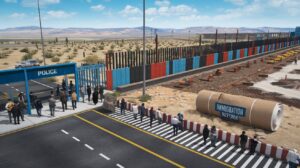Trump’s citizenship voting database is the latest flashpoint in America’s heated debate over election integrity and privacy. As recent revelations show the Trump administration is expanding the SAVE (Systematic Alien Verification for Entitlements) database to flag alleged non‑citizen voters, privacy advocates, election officials, and legal experts are raising alarms. Combining NPR’s June 29 coverage with insights from KUOW, CyberScoop, PBS, and more, this comprehensive report explores the mechanics, controversy, and potential consequences of this polarizing policy shift.
What is the SAVE voting‑citizenship database?
The SAVE database is a system run by U.S. Citizenship and Immigration Services (USCIS), originally intended to verify eligibility for public benefits. Under the Trump DOJ’s recent push, it’s being repurposed to screen voter rolls for citizens based on federal immigration records.
DHS officials report having run more than nine million voter registrations through SAVE, finding a 99.99% match rate to U.S. citizenship. Still, this hasn’t been independently verified. And critics worry the system overlooks many naturalized citizens or those never recorded in immigration databases.
Technical limits and privacy pitfalls
SAVE has always been incomplete. It only captures individuals who interacted with immigration authorities, but it omits a broad swath of legal residents and citizens.
The Trump administration recently enabled bulk queries and searches using Social Security numbers, triggering concerns of mass voter roll scans and mapping voters’ personal data across agencies. Electronic Privacy Information Center warned it’s a “hair‑on‑fire” privacy issue that needs sunlight and public scrutiny kuow.org.
The political context: pressure and policy
Trump has repeatedly pushed claims of non‑citizen voting without presenting credible evidence. The SAVE expansion fits within broader GOP efforts—the House-passed SAVE Act, DOJ lawsuits against states like North Carolina, and conservative executive orders—to require proof of citizenship for federal voting forms.
These moves build on the March 2025 executive order mandating proof of citizenship on the federal mail-in form and threatening to withhold funds from non‑compliant states brennancenter.org.
Risks of disenfranchisement
States like Arizona illustrate the stakes: flawed documentation systems wrongly flagged 200,000 eligible voters as unverified—some held up for decades on voter rolls.
Legal experts warn that SAVE is untested for this purpose. USCIS veteran Doris Meissner suggested limited pilot programs before rolling it out nationwide, but critics say accuracy remains questionable.
Meanwhile, bulk queries could inflate “non-citizen” listings—many of whom are naturalized or never met immigration databases—giving a false pretext to purge voters.
Legal backlash and what’s next
Civil rights groups and Democratic attorneys general have filed lawsuits against the executive orders. In April 2025, a federal court blocked the EAC mandate requiring documentary proof of citizenship via federal forms.
Sen. Padilla, among others, is demanding detailed answers from USCIS on SAVE’s accuracy and protocols cyberscoop.com. With pending cases and anticipated legal challenges, the fate of SAVE’s voting role hangs in the balance.
Conclusion
The Trump citizenship voting database debate centers on whether streamlining citizenship verification is a legitimate election safeguard or a form of voter suppression cloaked in data tools. With questions about database accuracy, civil liberties, and federal overreach unresolved, the future of this initiative remains uncertain.
Unless more transparency, rigorous testing, and public engagement are mandated, many legacies of potential disenfranchisement may persist—even if the courts eventually curtail executive authority.
Subscribe to trusted news sites like USnewsSphere.com for continuous updates.





